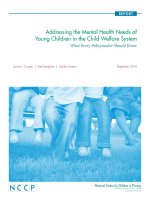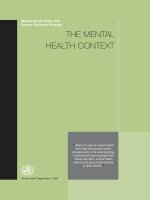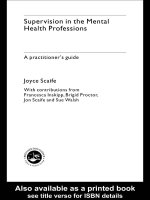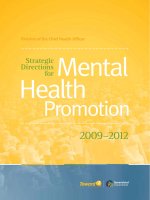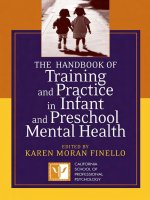Building Awareness of the Mental Health Issues of Asian American
Bạn đang xem bản rút gọn của tài liệu. Xem và tải ngay bản đầy đủ của tài liệu tại đây (490.66 KB, 41 trang )
The University of San Francisco
USF Scholarship: a digital repository @ Gleeson Library |
Geschke Center
Master's Projects and Capstones
Theses, Dissertations, Capstones and Projects
Fall 12-18-2015
Building Awareness of the Mental Health Issues of
Asian American College Women
Julie S. Baek
Follow this and additional works at: />Part of the Student Counseling and Personnel Services Commons
Recommended Citation
Baek, Julie S., "Building Awareness of the Mental Health Issues of Asian American College Women" (2015). Master's Projects and
Capstones. 217.
/>
This Project/Capstone is brought to you for free and open access by the Theses, Dissertations, Capstones and Projects at USF Scholarship: a digital
repository @ Gleeson Library | Geschke Center. It has been accepted for inclusion in Master's Projects and Capstones by an authorized administrator
of USF Scholarship: a digital repository @ Gleeson Library | Geschke Center. For more information, please contact
University of San Francisco
Building Awareness of the Mental Health Issues of Asian
American College Women
A Field Project Presented to
The Faculty of the School of Education
International and Multicultural Education Department
In Partial Fulfillment
Of the Requirements for the Degree
Master of Arts in International and Multicultural Education
by
Julie S Baek
December 2015
Building Awareness of the Mental Health Issues of Asian
American College Women
In Partial Fulfillment of the Requirements for the Degree
MASTER OF ARTS
in
INTERNATIONAL AND MULTICULTURAL EDUCATION
by
Julie S Baek
December 2015
UNIVERSITY OF SAN FRANCISCO
Under the guidance and approval of the committee, and approval by all the members, this
field project has been accepted in partial fulfillment of the requirements for the degree.
Approved:
Dr. Onllwyn C. Dixon
Instructor/Chairperson
December 7, 2017
Date
ii
TABLE OF CONTENTS
Page
Chapter I—Introduction ......................................................................................................1
Statement of the Problem ........................................................................................1
Purpose of the Project ...........................................................................................5
Theoretical Framework .........................................................................................6
Significance of the Project ....................................................................................11
Definition of Terms................................................................................................12
Chapter II—Review of the Literature ...............................................................................13
Introduction ...........................................................................................................13
Asian American and the Model Minority Myth ...................................................14
Family Pressure and Obligations .........................................................................17
Underutilization of Mental Health Services by Asian Americans ........................20
Lack of Study of the Mental Health Struggles of Asian American Women ........23
Summary ...............................................................................................................25
Chapter III—The Project and its Development ................................................................27
Description of the Project .....................................................................................27
Development of the Project ..................................................................................27
The Project ............................................................................................................29
Chapter IV—Conclusions and Recommendations ...........................................................30
Conclusions ...........................................................................................................30
Recommendations .................................................................................................31
REFERENCES .................................................................................................................33
iii
1
CHAPTER I
INTRODUCTION
Statement of Problem
In a heartbreaking poem entitled “Suicide Note,” Janice Mirikitani (1987)
expresses the thoughts of an imaginary woman of Asian descent who decides to commit
suicide:
How many notes written. . .
ink smeared like birdprints in snow.
not good enough
not pretty enough
not smart enough
dear mother and father.
I apologize
for disappointing you.
I’ve worked very hard,
not good enough
harder, perhaps to please you.
If only I were a son, shoulders broad
as the sunset threading through pine,
I would see the light in my mother’s
eyes, or the golden pride reflected
in my father’s dream
of my wide, male hands worthy of work
and comfort.
I apologize.
Tasks do not come easily.
Each failure, a glacier.
Each disapproval, a bootprint.
Each disappointment,
ice above my river.
So I have worked hard.
not good enough
My sacrifice I will drop
bone by bone, perched
on the ledge of my womanhood,
fragile as wings.
not strong enough
It is snowing steadily
2
surely not good weather
for flying—this sparrow
sillied and dizzied by the wind
on the edge.
not smart enough
I make this ledge my altar
to offer penance.
This air will not hold me,
the snow burdens my crippled wings,
the tears drop like bitter cloth
softly into the gutter below.
not good enough
not strong enough
not smart enough
Choices thin as shaved
ice. Notes shredded
drift like snow
on my broken body,
covers me like whispers
of sorries
sorries.
Perhaps when they find me
they will bury
my bird bones beneath
a sturdy pine
and scatter my feathers like
unspoken song
over this white and cold and silent
breast of earth.
This poem reveals the secret suffering and sense of guilt of a young Asian American
female college student. Feeling she is not good enough and has disappointed her parents
because of her perceived academic failures she ends her life by jumping to her death. Her
inner thoughts, shared as a suicide note to her parents, reveal her struggle with academic
and family pressures that ultimately led her to think suicide was the only option she had
to escape her pain.
According to the Asian American Psychological Association (AAPA) (2012),
referencing 2007 national suicide statistics, suicide is the 8th leading cause of death for
3
Asian Americans, a large and diverse group of various ethnicities, languages, etc., and the
11th leading cause for all racial groups combined. Suicide is the second leading cause of
death for Asian Americans 15 to 34 years old. Furthermore, U.S.-born Asian American
women were found to have higher lifetime rates of suicidal thoughts (15.9%) compared
to 13.5% for the general population.
The National Alliance on Mental Illness reports among all women between the
ages of 15 to 24, Asian Americans have the second highest suicide rates across all racial
or ethnic groups (as cited in Africa & Carrasco, 2011). Also, Asian American girls in
puberty have the highest rates of depression across all racial and gender groups (Africa &
Carrasco, 2011). In college, Asian American students experience a higher level of
depression than Caucasian students (Africa & Carrasco, 2011; Young, Fang, & Zisook,
2010). This population also has a higher level of suicidal thoughts than Caucasians
(Wong, Brownson, & Schwing, 2011). While many Asian American students suffer from
mental health issues, only 27% of them seek professional care or treatment (Africa &
Carrasco, 2011). The high rate of depression and underutilization of mental health
services among Asian American students along with other risk factors like family conflict,
viewing one’s self as a burden to others, and experiences of discrimination are predictors
of increased suicidal thoughts and attempts (AAPA, 2012; Africa & Carrasco, 2011).
However, little is known about what makes this population of students take their
own lives at higher rates than their ethnic counterparts because of a paucity of empirical
research on the issue (Africa & Carrasco, 2011; Noh, 2007). The model minority myth
suggests Asian Americans are more academically, economically, and socially successful
than any other racial groups because of unique Asian cultural values that emphasize hard
4
work, strong family values, and/or stronger belief in the idea of American meritocracy
(Suyemoto, Kim, Tanabe, Tawa, & Day, 2011). Additionally, it is appropriate to
acknowledge high rates of distress associated with trauma from political and economic
turmoil, in the case of Vietnamese, Cambodian, Laotian and Hmong refugees and
diversity in presentation and expression of psychological and psychiatric distress among
Asian Americans (somatization of symptoms) can complicate mental health issues within
this population (Africa & Carrasco, 2011).
Particularly, the failure to more fully examine the intersectional identities of
Asian American women is a contributing factor that makes their experiences, especially
related to mental health, unheard and unacknowledged. The compounding effects of
racial and gender discrimination and cultural and family pressures against Asian
American women marginalize and situate them as the other. Therefore, their experiences
and issues are rendered invisible (Foo, 2002).
I experienced psychological struggle firsthand when I came to the U.S. as an
exchange student from South Korea. During that time, I was unaware that my change in
eating habits had something to do with my mental health. I had to study hard since I came
all the way from my home country at great expense. Also, I had to contend with stress
related to cultural and language differences while maintaining good grades. Loneliness
resulted from being away from family and friends. In addition, the pressure to study hard
to fulfill family expectations eventually caused me to be abnormally preoccupied with
food. Studying and living abroad was indeed a great opportunity to make friends from
different countries and explore new languages and cultures. However, I did not know
what I was experiencing was common. I was not aware I needed to take care mental of
5
my health instead of ignoring what was happening to me. It was also hard to tell other
people what my problems were. I was unsure how to broach the subject and was
embarrassed to share my mental health struggles. Also, I did not know what resources
were available. My personal experiences, along with the statistical realities of Asian
American women and suicide, highlight the importance of educating Asian American
women college students at the University of California, Berkeley (UC Berkeley) in order
to increase awareness of their needs to manage their mental health as stridently as they
manage their academic studies, helping them to obtain tools to stay healthy both mentally
and physically, as well as informing them about available campus resources.
Purpose of the Project
The purpose of this project is to develop a video presentation to highlight campus
and community resources that could help Asian American women college students
struggling with mental health issues and promote their mental wellness. This project
attempts to address the factors impacting Asian American women college student’s
mental health issues and examine what kind of resources UC Berkeley provides to
support this group.
The presentation could be embedded on an Asian American student organization
website where Asian American women college students would be able to easily access
them. Another purpose of this project is to increase campus awareness of the unique
needs of this population of students. Ultimately, this project is to inform students that
they are supported and inviting them to become more empowered in addressing their
mental health.
6
Theoretical Framework
This project adopts critical race theory (CRT) and Asian critical race theory
(AsianCrit) as the theoretical framework. CRT provides a critical lens to understand how
dominant ideology has perpetuated and maintained racism and shaped the experiences of
people of color in the US. AsianCrit, building on CRT, focuses on Asian Americans and
the unique ways they have been marginalized. In particular, I focus on the tenet of
intersectionality as it gives a deeper understanding of how racial and other social
identities, including gender, intersect to shape the experiences of Asian American
women. CRT and AsianCrit with a focus on intersectionality are critical tools for
interpreting Asian American women students’ experiences in college.
Critical Race Theory
Before looking into AsianCrit, it is important to understand the origins and tenets
of CRT as AsianCrit is built upon CRT. CRT first appeared in the field of legal studies in
opposition to the dominant legal system of racial oppression during the post-Civil Rights
Movement in the 1970s. The discontent with a failure of racial reform spawned CRT
movement among legal scholars (Rimando, 2011). Derrick Bell, African American
professor at Harvard Law School and one of the first CRT scholars, quoted the Biblical
verse from the Jeremiah who lamented over hopeless salvation for his people saying,
“The harvest is past, the summer is ended, and we are not saved” (as cited in LadsonBillings, 2005, p. 115). Bell believes that this verse describe racialized experiences of
people of color, especially African Americans (Ladson-Billings, 2005). After Bell
resigned, students at Harvard Law School took over the CRT movement, demanding to
hire a scholar of color and add a course that addresses race and racism, which contributed
7
to the student-led “Alternative Course” (Rimando, 2011). This course inspired other
scholars and influenced further movements. Critical legal studies (CLS) conferences held
in the 1980s were critical events for the development of CRT as scholars who attended
the conferences brought the issue of traditional legal studies into the discourse to unveil
the hegemony (Rimando, 2011). Some scholars of color, however, were disappointed at
the existence of racial power relations “within CLS itself” and established their own
community, which resulted in an emergence of CRT (p.13). In contrast to the CLS
movement that failed to explain how race and racism influence legal studies in the US,
CRT theorized race and analyzed the racism that results in social inequities of the
minority groups (Hiraldo, 2010).
Even though CRT emerged in the legal field, the scholars of higher education
adopted CRT “as a tool to challenge colorblindness and analyze the ways that race and
racism function to oppress people of color in postsecondary education system” (Museus,
2013, p. 20). A deliberate work on identifying the key tenets of CRT by various scholars
in higher education resulted in the following: (1) the centrality and intersectionality race
and racism; (2) counter-storytelling; (3) interest convergence; (4) Whiteness as property
rights; and (5) challenging the dominant ideology (Ladson-Billings & Tate, 1995). Even
though researchers from various field areas have brought CRT into their researches with
different key tenets depending on their focus, as Rimando (2011) stating, “they are all
aimed in the same direction of critical thought and research around race” (p.13). As the
purpose of CRT is to uncover the “patterns of exclusion that exist in the U.S. society,” it
provides a critical perspective to see the struggles and obstacles of the underrepresented
8
students of color in higher education (Hiraldo, 2010, p. 54). One of the major tenets in
CRT is the centrality and intersectionality of race and racism (Buenavista & Chen, 2013).
Having the centrality of race as a major tenet, CRT also considers the
intersectionality that challenges a single identity. The CRT framework acknowledges the
diverse identities, experiences, and perspectives that influence the lives of people of color
(Rimando, 2011). Therefore, it provides a critical lens not only to see the reality of racism
rampant in our society but also to understand the experiences of ethnic or racial groups
that have been masked by the dominant ideology. Teranishi, Behringer, Grey, and Parker
(2009) articulated how CRT challenges the destructive myth that has constructed racial
stereotypes to students by stating:
CRT has been particularly useful for the critique of deficit thinking—the framing
of racial inequities as a result of individual deficiencies—by providing alternative
pedagogies and methodologies through which scholars and students can “unlearn”
stereotypical thinking about race. (p. 58)
The hidden motive of projecting an image of the model minority to Asian Americans is,
as Chang (1993) highlights, to mask the historical realities of discrimination and violence
as well as the contemporary problems of Asian Americans, thus sustaining white
privilege. Rimando (2011) draws upon the CRT framework to examine the model
minority stereotype, explaining:
The CRT framework has been very effective to examine the stereotypes and other
negative experiences that have contributed to Asian American and Pacific
Islander student achievement gaps. (p. 6)
CRT creates a space to bring inequity existed in the higher education system into
discussion to develop institutions and students affairs services that reflect the cultural
diversity and the needs of students from diverse backgrounds. Therefore, CRT would be
useful to unearth and challenge the educational inequalities of students of color.
9
Asian Critical Race Theory
Despite of dichotomous characteristic of CRT that focused “the lens of race on
either issues of black or white” when it first came out, it has evolved into a theoretical
perspective that encompasses various ethnic groups and identities (Rimando, 2011).
Scholars who study Asian Americans have recognized a need for an analytical framework
that focuses on this population to understand how race and racism has influenced their
experiences in the U.S. society, which resulted in AsianCrit (Museus, 2013). AsianCrit
provides, as Museus (2013) explains, “a refined set of uniquely tailored tenets that can
further advance critical analyses of racism and Asian American lives” (p. 23). Museus
(2013) identifies seven tenets of AsianCrit as follows:
Asianization: The U.S. society has racialized Asian Americans by lumping them
into a single Asian category and stereotyping them as yellow perils in the past and
a model minority at present. Such racialization was an effective means to oppress
Asian Americans and change laws and policies against this population, which
have given a huge impact on their lives;
Transnational Contexts: AsianCrit highlights both the past and present national
and international contexts that help us to understand how racism has shaped the
experiences of Asian Americans;
(Re)Constructive History: AsianCrit emphasizes the process of re-analyzing
history to reveal racism that has prevailed in the U.S. society towards Asian
Americans. Museus (2013) highlights that “an analysis of Asian American history
can inform understandings of the current conditions of Asian American
communities and help comprehend how education can be (re)shaped to better
10
engage and foster success among Asian American students in higher education”
(p. 25);
Strategic (Anti)Essentialism: Building on the notion that race is socially
constructed phenomenon (Ladson-Billings & Tate, 1995), strategic
(anti)essentialism recognizes that dominant ideology promotes racialization of
Asian Americans. However, it also believes that Asian Americans can engage
activities against the oppression (Museus, 2013);
Intersectionality: This tenet stems from the notion that racism intersects with
other systems of oppression including sexism, classism, and heterosexism, which
influence the lives of Asian Americans. Museus (2013) stressed that
“intersectionality can help facilitate deeper and more complex multilayered
analyses of the ways in which social structures, political processes, and identities
intersect to create certain conditions, realities, and experiences than what already
exists” (p. 27);
Story, Theory, and Praxis: AsianCrit emphasizes the importance of these three
interconnected elements for a critical analysis of Asian American experiences.
The belief of AsianCrit is that the stories of Asian Americans affect theory, theory
directs practice, and practice brings their voices (Museus, 2013); and
Commitment to Social Justice: The ultimate purpose of AsianCrit is to end all
types of oppression.
AsianCrit can be a useful theoretical framework for this research as it gives a critical lens
to analyze the experiences of Asian American female students in college. AsianCrit is
telling in this project not only unveils the reality of Asian American college students but
11
also encourages them to engage in the student-lead activities to improve the current
conditions.
Significance of the Project
This project aims to increase awareness of Asian American college women’s
mental health issue. The primary audience of this project is Asian American college
women, helping them to increase self-awareness in their mental health and encourage
them to pay more attention to their mindfulness. The stigma associated with mental
illness and mental health services and internalized gender expectations of women have
forced them to be silent, which does not allow them to take care of their mental health.
This project hopes to inform Asian American college women that their mental health
matters and that their mental struggles do not result from their fault. This process could
help them to have more positive attitude towards talking about their mental health and
seeking psychology services. Ultimately, I hope that Asian American women students in
college discuss their own issue and be active in bringing more campus and community
resources for themselves.
In addition, this project addresses the changes at all levels including individual,
family, campus, and community. The mental health issue among Asian American college
women has been invisible, and limited resources have been provided due to the paucity of
attention, and empirical and interpretive researches. Recently, UC Berkeley has lost a
psychology counselor who focused on Asian American students and no plan in the near
future to hire a psychologist who is responsive to Asian cultures. This project hopes to
break internalized model minority stereotype on Asian American students in general and
women in particular and draw more attention to the issues of Asian American women to
12
develop the school environment, student affairs services, and mental health care services
that reflect diverse experiences of this demographic group, thus creating more safe space
for all students regardless of their race, gender, religion, and sexual orientation.
Definition of Terms
1) Acculturative Stress: The stress that directly results from the difficulties and
stressors that arise during acculturation. The term is often used interchangeably with
acculturative stress; however, the latter more emphasizes the struggles and stress
(Castillo, Zahn, & Cano, 2012).
2) Depression: A mental disorder marked by a lack of interest and pleasure in daily
activities, inability to focus, lack of energy, insomnia, feelings of worthlessness and
guilt, or suicidal ideation (American Psychological Association, n.d.).
3) Mental health: Successful performance of mental function throughout the life cycle,
resulting in productivity activity, fulfilling relationships, and ability to adapt to
change and cope with stress (American Psychiatric Association, 2009).
4) Mental illness: Mental disorders marked by changes in thinking, mood, and behavior
or combination (American Psychiatric Association, 2009).
5) Video presentation: In this field project, it refers to a series of slides that contain
Asian American college women’s mental health issues and resources available on
campus and community.
13
CHAPTER II
REVIEW OF THE LITERATURE
Introduction
According to Chan (2003),
Although Asian Americans in general are vulnerable to psychosocial stresses
because of their cultural differences and minority group status, psychological
problems appear to be more prevalent among foreign-born immigrants
(particularly refugees) than among people of Asian descent born in this country.
However, despite the need for mental health services within both groups, research
has shown that Asian Americans have generally not used such services in
proportion to their numbers in the population. Asian cultural values, which
emphasize stoicism and discourage expression of feelings, contribute to this
underutilization. In addition, the absence of linguistically and culturally
appropriate services in many areas limits outreach to Asian American
communities. (p. 189)
In an effort to augment Chan’s perspective, this chapter highlights literature that
addresses the psychosocial issues many Asian American college students contend with.
Despite a paucity of empirical studies on this topic, efforts to illuminate Asian American
college students’ mental struggles have continued.
In spite of the diversity within Asian American groups, statistical data has
aggregated their different experiences, showing higher academic achievement among
Asian American students (Lew, 2006). This results in seemingly positive stereotypes
about Asian American, labeling them as a model among minority groups in the U.S.
(Chan, 2003). Such positive conception of a model minority, however, has long had
deleterious effects on Asian American college students. It not only results in a great deal
of pressure on them but also obscure their academic and mental health struggles. The
literature that addresses Asian American college students and mental health reveals this
population has a higher suicide rate and reports depressive symptoms more than other
ethnic or racial groups (Chu & Sue, 2011). However, Asian American college students
14
show the lowest utilization of mental health services and high dropout rates during
mental health treatment. In particular, Asian American women aged 15 to 24 have the
highest suicide rates among all racial or ethnic groups but only 27 percent of them seek a
professional assistance (National Alliance on Mental Illness, 2009).
The high academic expectations on Asian American college students are also
forced by their parents at home. Moreover, Asian American college students have
difficulty developing their own identity, experiencing value conflicts between Asian and
Western cultures. Even though Asian American college students are very likely to be
mentally distressed, these students are less likely to seek professional help than other
ethnic groups due to the stigma on mental health illness and counseling and
psychological services (Africa & Carrasco, 2011).
While reviewing the research about Asian American college students’ mental
health, four themes emerged. Therefore, this review of literature focuses on: (1) Asian
Americans and the model minority myth; (2) lack of study of the mental health struggles
of Asian American women; (3) family pressures and obligations; and (4) underutilization
of mental health service. In addition, I examined what suggestions researchers have for
better supporting Asian American students suffering from depression in college.
Asian Americans and the Model Minority Myth
The notion of a model minority first appeared in a 1966 New York Times
Magazine article written by UC Berkeley Professor William Peterson to describe
Japanese Americans who, through their efforts, were increasing their social status
financially and educationally (Victoria, 2007). Since then, the idea has been perpetuated
in mainstream publications and programs such as Time, The New York Times, The New
15
York Times Sunday Magazine, Fortune Magazine, books like Battle Hymn of the Tiger
Mother by Amy Chua and Top of the Class: How Asian Parents Raise High Achieversand How You Can Too by Dr. Soo Kim Abboud, and television shows like Glee, ER,
Grey’s Anatomy. The U.S. Department of Education has aggregated data of Asian
students under the single category, Asian, which fails to reflect diversity and complexity
in groups (Southeast Asia Resource Action Center, 2013). Students from Asian cultural
backgrounds have been categorized as a single group, however, there are more than 50
different subgroups including Indian, Bangladeshi, Cambodian, Filipino, Hmong, Laotian,
Pakistani, Thai, Vietnamese, etc. (Islam et al., 2010). The problem with aggregated data
is it masks the inequalities and struggles that Asian American college students experience.
For example, Southeast Asia Resource Action Center (2013) notes that current
educational data conceals the experiences of Southeast Asian American students. The
existing educational data overlooks the needs of Asian American students at risk.
The model minority stereotype has also exacerbated the problem of lumping
Asian Americans into a single category and perpetuates the marginalization of this
population. The model minority myth, a subtle form of racism, suggests Asian Americans
excel economically, academically, professionally, and personally compared to other
minority groups because they possess cultural values that stress hard work, mental
fortitude, personal responsibility, familial connections, etc. (Chan, 2003; Rimando, 2011;
Victoria, 2007).
Consequently, Asian American students study hard and perform well at school.
Nevertheless, this obscures their diverse experiences and struggles. While some Asian
American ethnic groups, particularly Chinese, Koreans, and Japanese, have a strong
16
record of academic achievement, there are others who have far lower levels of
achievement than their non-Asian peers. Moreover, even when educational achievement
has led to occupational success, many Asian Americans encounter a glass ceiling that
prevents them from being promoted or perceived as leaders (Chan, 2003).
Iwamoto, Liu, and McCoy (2011) suggested that the model minority myth
assumes “Asian Americans experience protective factors associated with genetics or
culture that contribute to high achievement and low incidence of mental health problems
in comparison with Whites and other ethnic and racial groups” (p. 296). Even though, on
the surface, the myth of the model minority appears to be positive, it can have a
deleterious impact on Asian Americans (Panelo, 2010). To illustrate, there is immense
pressure for Asian American college students to excel academically, which can lead to
psychological difficulties. Dharma (2011) examined “casualties” who suffered from high
pressure to succeed and found out that many of them devoted “their emotional well-being,
their passions, their identities; some give up on life” to achieve academic success (p. 2).
As Asian Americans mature, they internalize the idea that self-esteem correlates to
external factors like education and career.
Psychological distress from the internalized perception that academic success is
the only way to validate their identities peaks during undergraduate years (Dharma, 2011).
High pressure that results from the model minority myth not only causes mental distress
but also causes many Asian Americans to suppress their own desires and personalities.
Instead of developing strong self-identities, Asian American students attempt to live up to
high standards and expectations, which in turn perpetuates the myth of the model
minority.
17
The model minority myth implies introversion and passive characteristics of many
Asian Americans is an indication they are satisfied with their lives in the U.S. (Arisaka,
2000). As a result, this can bring about devastating psychological issues including
depression, anxiety, stress, eating disorders, and lack of self-esteem (Dang, 2013).
Equally as significant, these misconceptions about Asian Americans mask their
individual lived experiences and contribute to their reluctance to seek mental health
services when needed.
Family Pressures and Obligations
Family pressures are critical factors that lead to depression among Asian
American college students (Yoon & Lau, 2008). Asian American students with
immigrant parents often experience intergenerational conflicts resulting from language
barriers, acculturation gaps, parents’ lack of knowledge about U.S. higher education, and
high expectations for academic success (Panelo, 2010). Wong, Brownson, and Schwing
(2011) conducted a multi-campus, national study involving 1,377 Asian American
college students’ across 66 campuses. The results indicated living with a family member,
gender, GPA, undergraduate status, religious affiliation, medication for mental health
concerns, living with a partner, and active participation in student organizations were
associated with suicidal ideation. Additionally, living with family, medication for mental
health concerns, undergraduate status, and active participation in student organizations
were related to serious consideration of suicide. The researchers also discovered among
the participants who had seriously considered suicide in the previous 12 months, recent
family, academic, and financial problems were the top three most frequently mentioned
events.
18
Moreover, Lee and Liu (2001) discovered Asian American college students
reported greater intergenerational family conflict compared to Latino/Latina and
Caucasian students. On one hand, Asian immigrant parents may not fully understand or
acculturate to mainstream American culture, and therefore, raise their children to
maintain Asian cultures and values. On the other hand, many Asian American college
students insist on assimilating into mainstream American culture in order to achieve
social acceptance. Specifically, some Asian American women college students find
balancing two different cultures difficult (Hahm, Gonyea, Chiao, & Koritsanszky, 2014).
Hahm et al. (2014) explored the family experiences of 16 young Asian American women
who were children of immigrants and reported a history of self-harm and/or suicidal
behaviors. The participants reported experiencing various types of disempowering
parenting styles that were characterized as: abusive, burdening, culturally disjointed,
disengaged, and gender-prescriptive parenting. Also, the women indicated feeling
paralyzed by divergent forces, trapped between a profound desire to satisfy their parents'
expectations and societal expectations and simultaneously wanting to rebel against the
image of the perfect Asian woman. The participants suffered in silence and engaged in
self-harm and suicidal behaviors. Family conflict between generations and cultural value
conflict among Asian American college students contribute to acculturative stress
(Castillo, Zahn, & Cano, 2012).
Castillo et al. (2012) studied the predictors of familial acculturative stress of 85
Asian American college students. The majority of participants were 1st and 2nd generation
U.S. citizens. Findings showed perceived acculturative family conflict and family
intragroup marginalization were associated with higher levels of familial acculturative
19
stress for participants. Family intragroup marginalization accounted for a statistically
significant proportion of the variance in familial acculturative stress after all variables
were controlled. The findings accentuate the need to recognize culture-specific stressors
of college students. Different generations acculturate at a different speed, which causes
acculturation gaps.
Usually, children of immigrants acculturate and learn English faster than their
parents. This results in them taking on roles such as “translators, cultural experts, and
even family representatives to the outside world” (Chung, 2001, p. 377). These additional
expectations become a burden to young Asian Americans. As they mature, the
acculturation gap gradually widens, which results in lack of communication and
connection. Chung (2001) found difference in acculturation levels negatively affected
Asian Americans’ mental health and help-seeking behaviors. The high expectation on
academic performance from Asian American parents has also been identified as a
contributing factor on psychological struggles among Asian American college students.
Panelo (2010) noted, “This idea of being the model minority student can be reinforced at
home by family and parents’ high expectations” (p. 150). The issue is many parents do
not see that their expectations result in unimaginable pressure that can contribute to the
development of mental health issues. As Asian Americans came to the US to “search for
a better life and a bright future for the family,” they expected their children to succeed
academically in order to insure career and social mobility (Chung, 2001, p. 376). The
idea of being a good son or daughter is perceived as academic and career success in
Asian cultures (Hahm et al., 2014). The research on influences of perceived parental
expectations has suggested Asian American college students more concerned about
20
school and family rather their developing sense of self-efficacy and identity separate from
their families out of fear of not living up to their parents’ expectations (Lee et al., 2009;
Saw, Berenbaum, & Okazaki, 2013). In addition, many of Asian American students are
likely to feel obligated to support their parents financially or physically as they get older,
which results in additional pressure (Lee et al., 2009).
Underutilization of Mental Health Services by Asian Americans
The high suicide and rates of depression have been a great mental health concern
among Asian American college women because they have the lowest utilization rate of
mental health services (Chu, Hsieh, & Tokars, 2011; Chu & Sue, 2011). Therefore,
underutilization of mental health service may be associated with “a combination of
institutional and sociocultural barriers” (Shea & Yeh, 2008, p. 158). Institutional barriers
come from a lack of culturally responsive practitioners and services. Many of mental
health services adopt Western counseling models that often contradict with students’
cultural backgrounds (Shea & Yeh, 2008). As mentioned earlier, Asian Americans are
highly diverse group, consisting of a number of subgroups. Each subgroup has a different
culture and immigration history, which results in different leading influences on mental
health. This requires different understanding and approaches to support their needs.
However, the lack of studies and attention masks the heterogeneity of Asian American
populations and their distinctive experiences and needs. Failure to reflect cultural aspects
keeps Asian American college students, in part, from utilizing mental health services.
Underutilization of mental health services perpetuates the invisibility of their struggles
and needs. However, as Chu and Sue (2011) noted, “Lower service use is not indicative
of lower need” (p. 10). Some of this can be attributed to social and cultural barriers.
21
Social and cultural barriers include “historical and cultural influences on coping
with personal problems, linguistic issues, limited knowledge about available services, and
a high level of social stigma attached to seeking psychological treatment for mental
health issues in the Asian community” (Shea & Yeh, 2008, p. 158). Even though mental
illness is commonly perceived negatively, it is much more stigmatized in Asian American
communities (Kwok, 2013). In Asian cultures, mental illness is often attributed to a lack
willpower that stems from the individual’s inherent weakness (Lee et al., 2009). In the
past, many Asians thought that mental illness is “a lack of harmony of emotions” caused
by evil spirits and did not consider it as a disease (Kramer, Kwong, Lee, & Chung, 2002,
p. 228). As a result, seeking professional mental health services is often perceived as
shameful (Chu & Sue, 2011). Asian cultural values, which generally emphasize
collectivism, family hierarchy, emotional self-control, and avoidance of shame stigmatize
mental health problems, perpetuates negative thoughts about accessing mental health
services. Asian American students adhering to traditional Asian culture values may seem
more likely to underutilize mental health services. However, the research findings about
acculturation and enculturation as a significant predictor of low help-seeking tendency
among Asian American college students vary. Some researchers have suggested Asian
American college students who are acculturated to mainstream American culture are
more open to mental health services. In contrast, other studies indicate there is no
significant correlation between acculturation and help-seeking behaviors (Ruzek,
Nguyen, & Herzog, 2011). Even though it is not clear whether cultural values directly
affect mental health services use, it is important to note that many current psychological
counseling services are not appealing to the needs of Asian American students.
